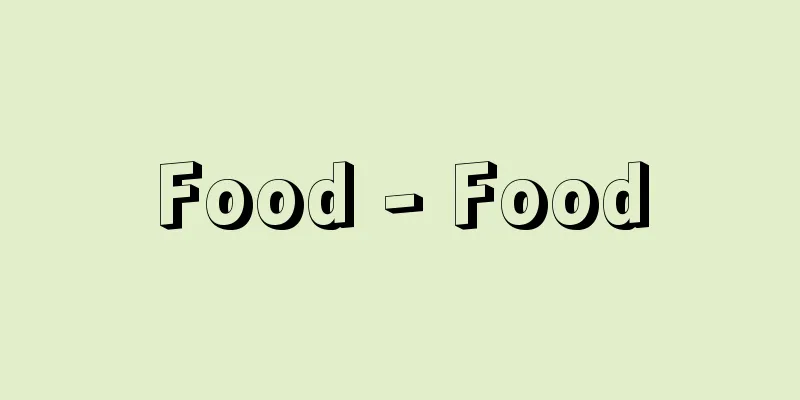Food - Food

|
It refers to something that is in an edible state and can be used directly by humans for eating. Food is the general term for food that has been cooked or processed to make it edible. Also, ingredients that can be made into food are called foodstuffs. For example, harvested rice is food, but if it is polished it becomes food, and cooked rice can be called food, along with other things. However, the scope of what is called food is not as clear as compared to food and food products. [Tomomi Kono] ClassificationFoods can be classified into several categories based on the type and form of ingredients, whether they are natural or synthetic, etc. There are also various methods for classifying foods depending on the purpose for which they are used. (1) Major categories: Animal foods, plant foods, and synthetic foods Food ProcessingMany foods are often supplied in a processed form. Some of these processing methods are ancient, but with the advancement of new technology, many processing methods that were not often used in the past are now being used. Food processing methods include polishing rice, milling wheat and rye, making noodles, bread, and confectionery using the resulting flour, producing starch from corn and potatoes, making candy from starch, producing sugar, and producing umami seasonings using starch through fermentation. Common processing methods include the brewing of sake, soy sauce, miso, vinegar, and other foods, the production of preserved foods through canning, bottling, drying, and salting, freezing, retort foods, and the production of fish paste paste products, and the smoking of ham and sausages to add flavor and preserve them. [Tomomi Kono] keepFoods, including some perishable foods, need to be preserved through processing, which ensures a stable supply. Preservation methods include refrigeration and freezing for perishable foods, and dehydration and sterilization followed by sealing in cans, bottles, or film packs. Refrigeration allows vegetables to be cooled to about 5°C shortly after harvest, allowing them to be preserved for several weeks to several months. Some fruits, such as apples, can be preserved for nearly a year using a method called CA storage, in which they are stored at low temperatures in air with a high carbon dioxide content. Freezing has made it possible to preserve foods for more than a year thanks to the development of quick freezing methods and the use of ultra-low temperatures using liquefied gas, and is used for meat and fish. Foods that have been quick frozen and specially stored at low temperatures are often thawed and sold as perishables. Dehydration methods include quick freeze-drying, low-pressure hot air drying, spray drying, and sun drying. Dried foods undergo a large amount of oxidation during storage, so they are sealed in containers such as cans and gases such as carbon dioxide or nitrogen are added to improve their shelf life. Also, with regular sealed packages, a small bag containing an oxygen absorber is now also enclosed to eliminate the oxygen inside and prevent changes. Moisture inhibitors may also be enclosed. Canned foods, bottled foods, and retort foods are examples of preservation through sterilization and sealing. Foods are subject to a large amount of change due to microorganisms when left as is, so sterilization improves their shelf life. For sterilization, the aforementioned items are sterilized by heat. In addition, for foods that deteriorate when heated, irradiation (potatoes, etc.) and fumigation (grains, etc.) are also used. [Tomomi Kono] componentEach food has its own unique nutritional value, so it is necessary to know how much of each nutrient is contained in each food. For this purpose, the composition of the food is analyzed. However, there is a large variation in the composition of each food. The composition of the food varies considerably depending on the place of origin, harvesting season, variety, rearing method, processing method, storage conditions, etc. Therefore, a standard composition is needed, and the "Fifth Revised and Enlarged Standard Tables of Food Composition in Japan" (2005, compiled by the Resource Survey Subcommittee of the Science and Technology Council, Ministry of Education, Culture, Sports, Science and Technology) was published. Nutrition surveys are compiled based on this table. Also, food is usually cooked before eating, and since the composition of the food changes during cooking, this point is now also included. [Tomomi Kono] standardWith regard to processed foods, there is a risk that priority will be given to products that are not substantial in content, to the addition of ingredients that are not particularly necessary for processing, or to products that look good only. For this reason, a system is needed whereby certain standards are established by law and products that meet these standards are given a mark. The most central system is the Japanese Agricultural Standards (JAS), which are deliberated and decided under the Act on the Proper Labeling of Agricultural and Forestry Product Contents. Foods that meet these standards and are approved are allowed to use the JAS mark. In addition, products that comply with fair regulations are given fair labeling. There are also foods that have voluntary standards, such as frozen foods and dairy products. [Tomomi Kono] distributionFoods go through various intermediate organizations from when they are produced until they reach the consumer. This is called food distribution. Distribution differs for each food, and some types of food take special routes. Usually, food flows in the order of producer → collection group (dealer) → wholesaler (market) → retailer. However, in cases where inspections designated by the government are required, such as livestock products, the necessary route may be taken. In addition, there are refrigerated and frozen foods that require temperature control during the distribution stage. Distribution almost always involves transportation. The costs of this transportation cannot be ignored, so ingenuity has been put into the form of food, transportation means, and packaging. In the past, food was consumed in the harvested area, but with the development of modern society, the population has concentrated in cities, and long-distance transportation has become the main form of food distribution. Therefore, fresh foods are also being improved to meet the conditions of transportation and storage. In particular, processing foods to increase the added value of fresh foods is very advantageous under the above conditions, and this is thought to be the cause of the increase in the consumption rate of processed foods. [Tomomi Kono] HygieneFood is the most important thing for human nutrition. If this food were to cause harm to humans, it would hinder a stable social life. Therefore, food safety is emphasized. There are several requirements for food safety. In other words, food must be hygienic and meaningful for nutritional supplementation. Among them, hygiene is the most important thing for food, and it is protected by law to ensure that food is hygienic and safe for consumers to eat. This is the Food Sanitation Act. The Food Sanitation Act is a mandatory law, and everyone living in Japan is obligated to follow it. In addition, in order to conform to the standards set out in the Food Sanitation Act, the conditions for spraying pesticides on agricultural crops, the conditions for feed and administration of medicines against diseases on livestock products, and the conditions for farming and storage of marine products are regulated or instructed by the relevant ministries and agencies. [Tomomi Kono] Problems with preserved foodsOne of the conditions for many people to live their daily lives with peace of mind is that food must be available at all times. For this reason, a certain amount of food must be preserved. In particular, rice, one of the most important foods in Japan, needs to be supplied steadily throughout the year. Problems that arise in the preservation of such foods include changes in the food. For example, grains are fumigated to prevent insect damage. The residue of fumigants during this process can be problematic. In addition, long-term storage can cause a deterioration in flavor. The taste of old rice and very old rice is also a problem due to preservation. In addition, qualitative changes cannot be prevented even when frozen for long periods of time, as with animal foods. Here too, the problem of deterioration in flavor arises. However, a compromise must be made somewhere between ensuring a constant supply of food and the deterioration of flavor. For these reasons, the deterioration of flavor is covered by highly processed foods. This is an unavoidable aspect of modern society. [Tomomi Kono] PackagingMost foods, except for fresh foods, require packaging. This is necessary to prevent deterioration and to keep a certain amount together. When fresh foods are displayed in appropriate units, such as at mass retailers, packaging for each unit is required. When packaging food, packaging materials appropriate for that food are required. Most packaging materials are made of plastic, but paper and aluminum foil are also widely used. As these also come into contact with food, it is necessary to prevent the transfer of substances harmful to health into the food. For this reason, food packaging materials are also subject to legal restrictions from a hygienic standpoint. [Tomomi Kono] "Food Science Specific Topics" edited by Yoshida Tsutomu, with Oda Naoko, Saito Susumu, Suzuki Yoichi, Baba Osamu, Bito Munehiro, Horiguchi Keiko, and Morita Hidetoshi (1999, Sankyo Publishing)" ▽ "Nutrition Science Series NEXT: Food Economics" edited by Yoshida Yasuji and Tajima Makoto (1999, Kodansha)" ▽ "New Food Encyclopedia" edited by Kono Tomomi, all 14 volumes (1999, Shinju Shoin)" ▽ "New Life Food Science - Based on the 5th Edition of the Standard Tables of Food Composition in Japan" revised edition by Mori Kazuo, Akabane Yoshiaki, and Kodari Makoto (2001, Kenpakusha)" ▽ "Food Encyclopedia" edited by the National Food Research Institute (2001, Asakura Shoten)" ▽ "Food Safety Systems and Science" by Shimizu Toshio (2006, Dobun Shoin)" ▽ "Food and Health: Nutritional Components and Processing of Food" edited by Naomichi Kunizaki (2006, Dobun Shoin) [Reference items] | | | food | | | food | | | | | | | | | | | | | food | | |Source: Shogakukan Encyclopedia Nipponica About Encyclopedia Nipponica Information | Legend |
|
人が食べるために直接使用できる、食用可能な状態のものをいう。食品を調理や加工などして、食べられるようにしたものの総称が食物である。また、食品の形態にすることのできる材料を食糧という。たとえば、収穫した米は食糧であるが、これを精米すれば食品となり、炊飯(すいはん)したものは、他のものとあわせ、食物とよぶことができる。ただ食物とよぶ範囲は、食糧、食品と比べ、あまりはっきりしていない。 [河野友美] 分類食品は、その材料となるものの種類、形態、あるいは自然品か合成品かといった違いにより、いくつかに分類することができる。またその分類法も、分類を用いる目的により各種のものがある。 (1)大別的分類 動物性食品、植物性食品、および合成食品 食品の加工多くの食品は、加工されて供給されることが多い。加工法には古来のものもあるが、新しい技術の進歩に伴って、従来あまり行われなかった加工法も多くとられるようになってきた。 食品の加工法としては、米などの搗精(とうせい)、小麦やライ麦などの製粉、つくった小麦粉を原料とした製麺(めん)、製パン、製菓などがある。また、トウモロコシ、いもなどからのデンプン製造、デンプンを使った製飴(せいたい)、糖類製造、さらにデンプンを原料に発酵法によるうま味調味料の製造といったものがある。一般的な加工法としては、酒、しょうゆ、みそ、酢などの醸造による製造、缶詰、瓶詰、乾燥、塩蔵などによる保存性食品の製造、冷凍、レトルト食品、魚肉のすり身を使用した練り製品の製造、ハム・ソーセージなどの風味づけとそれに保存性をもたせる薫製(くんせい)製造など、各種のものをあげることができる。 [河野友美] 保存食品は、生鮮食品の一部を含め、加工などによって保存が必要で、それにより安定供給が確保できる。保存方法には、生鮮食品では冷蔵・冷凍などの方法、加工によるものでは、脱水、殺菌したあと缶や瓶あるいはフィルムのパックなどに密封といった各種の方法がとられる。冷蔵では、野菜類を収穫後短時間のうちに5℃程度まで冷却し、数週間から数か月間保存が可能である。また、リンゴなど一部の果実では、二酸化炭素含量を多くした空気中で低温で貯蔵するCA貯蔵とよばれる方法などもあり、こうした方法だと1年近く保存が可能である。冷凍では、急速凍結法の発達や液化ガスによる超低温の利用で保存は1年以上可能となり、肉や魚などに利用されている。急速凍結して特別に低温保存をしたものは、解凍し、生鮮品として販売されることが多い。脱水では、急速凍結乾燥、低圧熱風乾燥、噴霧乾燥、天日乾燥など、各種の方法がとられる。乾燥したものは、保存中、成分の酸化が大きいので、缶などの容器に密封し、二酸化炭素や窒素ガスなどを入れて保存性を増す。また、通常の密封包装品では、脱酸素剤の入った小袋をともに封入し、中の酸素をなくして変化を防ぐ方法もとられるようになった。このほか防湿剤も封入することがある。殺菌、密封による保存は、缶詰、瓶詰、レトルト食品などがあげられる。食品は、そのままでは微生物による変化が大きいので、殺菌すれば保存性が増す。殺菌には、前述のものでは加熱殺菌が行われる。このほか、加熱すると変質するような食品の場合は、放射線の照射(ジャガイモなど)、燻蒸(くんじょう)(穀物など)も行われる。 [河野友美] 成分食品は、それぞれに特有の栄養的価値をもつので、どういう食品にはどの栄養成分がどれくらい含まれているかを知る必要がある。このために食品の成分の分析が行われる。ただし、食品は個々のものに成分のばらつきが大きい。産地、収穫期、品種、飼育法、加工法、保存状態などにより、成分はかなり大きく変動する。それゆえ標準となる成分が必要となるため、『五訂増補日本食品標準成分表』(2005・文部科学省科学技術・学術審議会資源調査分科会編)が出されている。栄養調査の集計などはこの表を基準に行われる。また、食品は通常調理して食用に供するが、この調理中の成分変化もあるため、この点も記載されるようになった。 [河野友美] 規格食品のなかでも加工品については、内容の実質が伴わないもの、加工上とくに必要と思われない成分の添加、あるいは見かけだけのよさなどが優先されるというおそれがある。そのため一定の規格を法律で定め、それに合致したものにはマークをつけるような制度が必要である。もっとも中心となるものはJAS(ジャス)(日本農林規格)であって、これは「農林物資の内容表示の適正化に関する法律」により、審議決定される。この規格に合致し、認可を受けた食品には、JASマークをつけることが許される。このほか公正規約によるものは、公正の表示が行われる。また自主規格のある食品もあり、冷凍食品、乳製品などがその例である。 [河野友美] 流通食品は、生産されてから消費者の手に渡るまで、各種の中間組織を経ていく。これを食品の流通とよんでいる。流通は食品ごとに異なり、種類によっては特殊な経路をとるものもある。通常は、生産者→集荷団体(業者)→卸売業者(市場)→小売業者の順に食品が流れる。しかし、畜産品のように国の指定した検査を必要とする場合には、これに必要な経路をたどることもある。さらに流通段階で、温度管理が必要な、チルド食品、冷凍食品もある。流通にはほとんどの場合輸送を伴う。この輸送によるコストは無視できないものがあり、食品の形態、輸送手段、梱包(こんぽう)などにくふうが凝らされるようになった。以前は収穫地において消費される形態が強かったが、近代社会の発展とともに都市に人口が集中し、長距離輸送が食品流通の主体となった。そのため、生鮮食品も、輸送や保存上の条件に合致するような改良が行われている。とくに加工食品にして生鮮食品より付加価値を高めることは、前記のような条件下には非常に有利となり、これが加工食品の消費比率を高める原因になっているとも考えられる。 [河野友美] 衛生食品は人の栄養補給上もっともたいせつなものである。もし、この食品が人に危害を及ぼすことがあっては、安定な社会生活が阻害される。そこで食品の安全性が重視されることになる。食品の安全性には、いくつかの要件が考えられる。つまり食品が衛生的で、栄養補給上有意義であるということである。なかでも、衛生的であることは食品にとってもっともたいせつなことで、食品が衛生的に安全に消費者の口に入るようにするため、法律によって守られている。それが食品衛生法である。食品衛生法は強制法で、日本に居住するすべての人がこれに従わねばならない義務がある。また、食品衛生法に定める規準になるように、農作物にあっては農薬の散布条件が、畜産物にあっては飼料や、疾病に対する薬剤投与の条件が、水産物にあっては養殖や、保存の条件が規制され、あるいは担当省庁によって指導されている。 [河野友美] 保存食品の問題多数の国民が安心して日常生活を送るためには、食品がいつでも手に入ることが条件の一つである。そのためある程度の食品を保存しておかねばならない。とくに、日本で最重要視されている食品の一つである米は、年間を通じて安定供給が必要である。こういった食品の保存上生ずる問題として、食品の変化があげられる。たとえば、穀物では、虫害を防ぐため燻蒸が行われる。この際の燻蒸剤の残存などが問題になる。また長期の保存により、風味の低下なども生ずる。古米や古々米などの味が問題視されるのも、保存によるものである。また動物性食品のように冷凍保存を長期に行う場合も質的な変化は防止できない。ここでも味の低下の問題がおこる。しかし食品がつねに確保されることと、風味低下は、どこかで妥協せざるをえない。こういったことからも、食品の高度加工による低下風味のカバーが行われることになる。これは近代社会の避けて通れない点である。 [河野友美] 包装食品は、生鮮食品以外の多くが包装を必要とする。これは変質を防止し、また一定の量をまとめるために必要である。生鮮食品については、量販店などのように適当な単位で食品を陳列する場合、単位ごとの包装が必要となっている。食品を包装する際、その食品に適した包装材が必要である。多くの包装材はプラスチック類が利用されているが、そのほか、紙、アルミ箔(はく)なども広く用いられている。これらも食品に接触するので、食品に健康上有害な物質が移行することを避けなければならない。このため食品包装材についても、衛生的見地からの法的規制が行われている。 [河野友美] 『吉田勉編著、小田尚子・斎藤進・鈴木洋一・馬場修・尾藤宗弘・堀口恵子・森田英利著『食品学各論』(1999・三共出版)』▽『吉田泰治・田島真編『栄養科学シリーズNEXT 食料経済』(1999・講談社)』▽『河野友美編『新・食品事典』全14巻(1999・真珠書院)』▽『森一雄・赤羽義章・小垂真著『ニューライフ食品学――五訂日本食品標準成分表準拠』改訂版(2001・建帛社)』▽『食品総合研究所編『食品大百科事典』(2001・朝倉書店)』▽『清水俊雄著『食品安全の制度と科学』(2006・同文書院)』▽『國崎直道編著『食べ物と健康――食品の栄養成分と加工』(2006・同文書院)』 [参照項目] | | | | | | | | | | | | | | | | | | | | | | |出典 小学館 日本大百科全書(ニッポニカ)日本大百科全書(ニッポニカ)について 情報 | 凡例 |
>>: Workplace struggle - shokuba tousou
Recommend
quasiparticle
…The excited state of a macroscopic object consis...
Capitularia (English spelling) [Latin]
A general term for the Carolingian kings of the Fr...
Vischer, P. (son) (English spelling) VischerP
...In the second half of the 14th century, the Pa...
Oil-powered waterwheel
…This is a water-lifting machine, but examples of...
Large drum (leather) - Okawa
...A type of Japanese percussion instrument. Also...
Deep-sea fish from the open ocean
...these fish are thought to have adapted to the ...
Occasionalism - Occasionalism
Also called the theory of contingency. A theory t...
Weasel Beetle - Weasel Beetle
A general term for pouched animals belonging to th...
Ascension to the throne
The Imperial heir (koushi) succeeds to the throne...
Turkish hat - tarboosh
A fez is a Muslim male hat in Egypt, Arabia, and T...
Yoroigata - Armor
This was once a lagoon located in the mid-western ...
Shinzaburo Asai
...A feudal lord in the Sengoku period. Commonly ...
Izumo Grand Shrine
It is located in Izumo, Chitose-cho, Kameoka City...
Aurora Lee
…In 1846, he married secretly and fled to Florenc...
rainbow lorikeet
...Nine species are found in the Lesser Sunda Isl...




![Ebetsu [city] - Ebetsu](/upload/images/67cb0a4ac9c6b.webp)



![Borzoi [species] (English spelling)](/upload/images/67ccde05da6f0.webp)
